Related Sites
Related sites is an advanced SEO tool for search engine optimisation that SEOs use to identify closely related websites in terms of their backlinks and overall backlink structure. Mining this data helps find valuable, relevant, and comparable theme-related links to build website authority within the online space. In addition, related sites are also a key tool in SEO for identifying competitors or potential partnerships for Link Building within your niche. Whether you're looking to promote your site or increase your competitive advantage against others in your market niche, Related Sites can help you achieve your objectives more efficiently and effectively. SEOs use Related Sites for Backlink Analysis and Research, Link Building, Digital Marketing & PR, and Competitor Analysis.
Take advantage of our free trial to perform backlink research in Site Explorer. You'll find the websites most similar to the site you are analysing.
How Related Sites Works
Related Sites is a powerful tool built into the Site Explorer section of Majestic that provides users with an automated list of up to 100 related websites through an advanced heuristic approach. As the name of this SEO tool suggests, related sites are those we believe, based on our heuristic analysis, to be "related" to each other. So, for example, if we examine the related websites for the famous pizza chain Dominos, we'll find that Pizza Hut and Papa Johns are very prominent and identified as highly related to Dominos as you can see in the following screenshot:

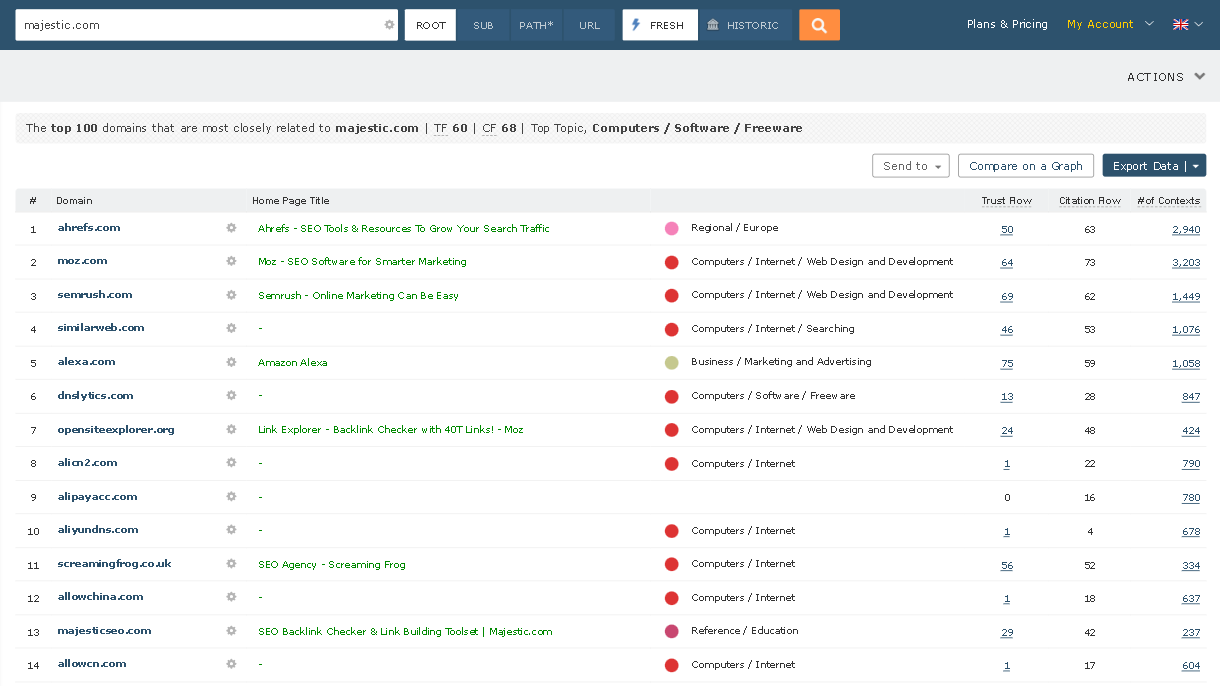
Being an established player in your niche, you may assume you know all your competitors and have a thorough understanding of them. However, new entrepreneurial initiatives or more aggressive Link Building SEO Strategies by existing competitors may modify the status quo of your online business landscape. Related Sites provides an up-to-date list of fresh insights into the dynamics of current and new competitors you can monitor and analyse to stay ahead of the competition.
Here is another example: the results of a search performed for the BBC website:
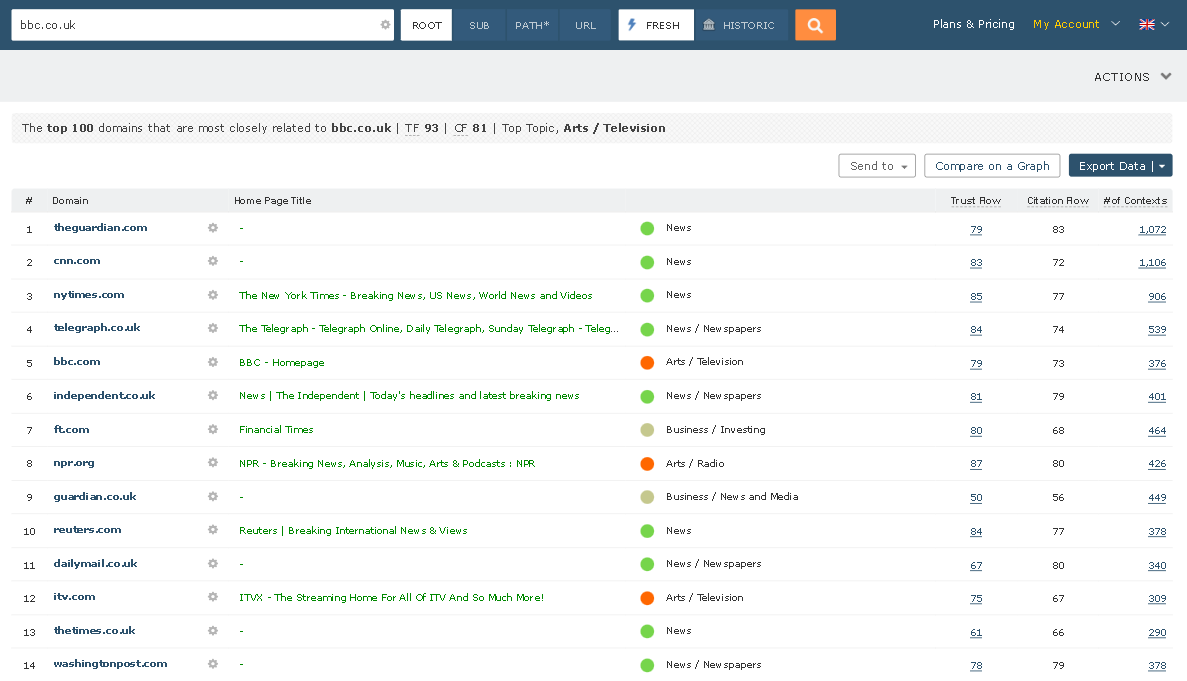
For each URL, related sites are freshly, constantly, and procedurally compiled using maps of the entire Internet. Link Context is the main data source to create these lists. Our crawlers identify and index backlinks, along with the content surrounding them. Authors and content creators tend to link to similar websites when writing. Not only will they be similar (or related), but they will increase the perceived quality of the page. In fact, Google invests a considerable amount of time and effort into their QR Guidelines to explain their point of view to Quality Raters who assign a quality score to every page they visit. From the author's perspective, it only makes sense to provide readers with interesting, quality editorial links to follow and learn more about their reading.
We use this data to evaluate their affinity and decide which websites are related.
Backlink Research
Backlink research is an invaluable analysis SEO professionals regularly perform to assess the authority and popularity of a website through an in-depth analysis of backlink profiles. SEOs use this analysis to identify potential changes and improve their link building strategies. Furthermore, backlink research provides a comprehensive review of the incoming links, allowing for a better understanding of the site compared to other related sites in their space.
The Backlink Research for Original Patty Men (OPM)
We performed an in-depth backlink analysis of OPM a local restaurant in Birmingham that is very popular amongst the staff here at Majestic. The following screenshot is a Related Sites report of the top sites our algorithms have identified. Keep in mind that this is backlink data for a small, local restaurant like many others in cities worldwide.
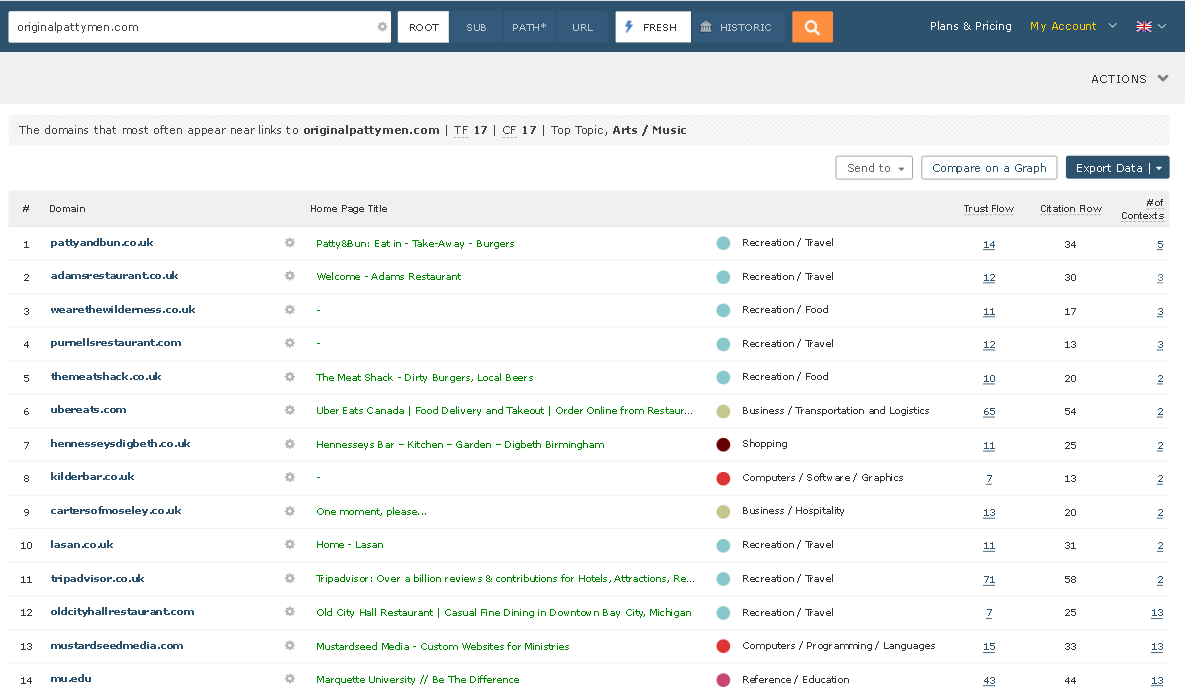
A quick view of the page titles in the list will immediately identify competitors, link building opportunities, and a short list of this restaurant's suppliers. OPM has 791 external inbound links in the Fresh Index at the time of this writing - a considerable number of backlinks for a small restaurant with a local reach.
It's worth noting that our algorithm keeps these lists topically relevant. Links to some of the Internet's most prominent sites like Google, Facebook, Twitter and AWS may be suppressed from the results
The Origin of Related Sites Data
When our spiders detect a link on a page, they note the presence of other links in the immediate vicinity, which are present in the text snippet. Groups of links tend to provide similar sites, which can also contain competitors. We derived the list of Related Sites in the previous image from our Link Context Data for OPM.
The following screenshot is the Link Context Data for adamsrestaurant.co.uk (the 4th entry in the previous list of related sites for OPM).
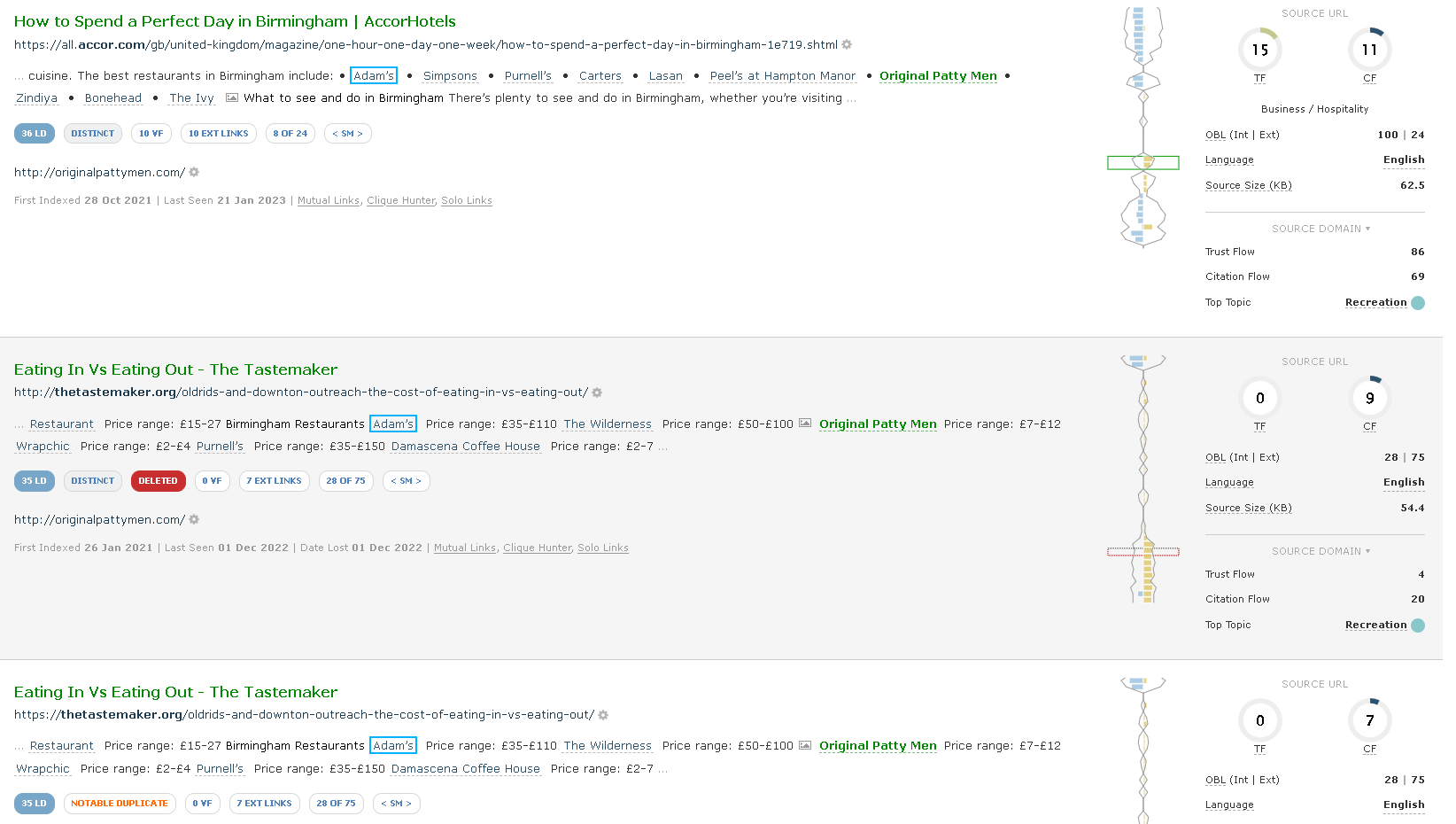
In this screenshot, we can see that adamsrestaurant is cited alongside OPM. A closer look at the content reveals how these backlinks originate from blog posts. These lists are the data sources used to determine whether the two websites are related. The authors have carefully chosen and placed the links in the blog post content. In fact, Link Context has identified their presence in low link density context items - the relatively narrow sections of link density charts that provide insights on the nature of the link (if it is an editorial link or of a different nature). Judging by the data provided by Link Context, we are almost certain that a person has curated this co-citation.
Another consideration is related to the mentions of both restaurants. These backlinks could originate from a well-prepared PR activity or simply because of an excellent Brand Reputation due to their success.
Digital PR and Content Creation
Content creators and Digital PRs use Related Sites to identify new audiences for outreach, gather data, and create editorial guidelines for content creation. For example, you can analyse websites close to yours and provide useful tips and links to assist readers in their customer journey or help them find new learning opportunities.
One angle could be to look for additional topics to enrich a blog post or write new articles in areas of interest you may not have covered. For example, suppose you have a blog that covers cinema and entertainment. In that case, your readers could be interested in learning about how a VPN works, how they can use it and which are the most popular and reputable VPN services. With the right link building strategy and outreach, such an article could attract new links from these (and perhaps other) websites. Let's consider another example: if you write about diets and physical fitness, you could try tapping into new audiences with an interest in mental wellness or perhaps gardening.
They may not be your direct customers. However, there can be affinities and overlapping interests between groups you can identify and create using Majestic Related Sites. With this mindset, both your content creation and link building strategies can reach new audiences and give your content another viewpoint.
Find Interesting Relationships Between Websites
What makes Related Sites so powerful is the limited time and effort you need to spend with this SEO tool to identify interesting relationships between sites - even for the smallest of websites with a hyperlocal reach.
Related Sites reports:
- Geographically Similar Sites;
- Competitors;
- Business Relationships between sites.
If we analyse the data for OPM, we could create groups of websites considering each restaurant's speciality - for example, street food could be a category containing Andy Low N Slow, Patty And Bun, and Meat Shack. A review of these sites suggested the creation of a high-end food category where we would place Michelin Star restaurants Adams, Purnells, and Carters of Moseley. We can find additional related sites by creating additional curated lists with the action cog of any domain name.
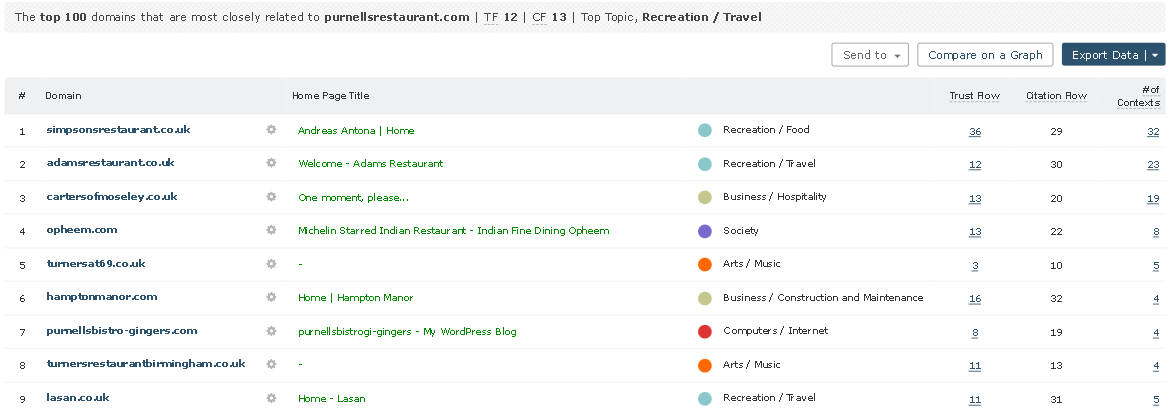

Outreach and Link Building Strategies
A well-planned outreach phase always precedes a successful Link Building Campaign to establish relationships with bloggers, journalists and industry-specific content creators. A smart outreach, combined with the right story, can generate many backlinks over short periods. However, in most cases, the objective is more about targeting a curated list of topic-related websites that are relevant to your business.
Backlinks from topically relevant websites can make a difference
Here's a great example:

We could attempt to identify more related sites by analysing this URL. To do so, hover over the action cog next to the linking page, as illustrated in the following screenshot:
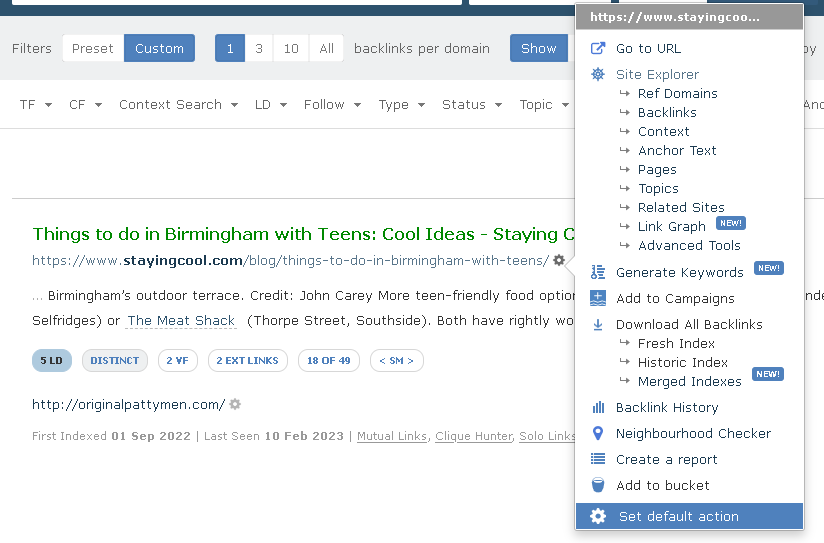
From the drop-down menu, choose Root Domain:

You will now have a new set of related sites to work with.
This procedure requires manual reviewing of all URLs. Unfortunately, not all websites will meet your requirements. At times a quick view of the title tag or Topical Trust Flow is enough to decide whether or not it falls into a category of interest:

Visualisation of Related Sites Data With a Scatter Graph
A list of domains isn't always the best way to present data: we're all a bit different - some of us are analytical, while others are more creative. Related Sites data can be viewed with a scatter graph. Scatter Graphs allow SEOs to position a website competitively against the Related Site's list of other domains.
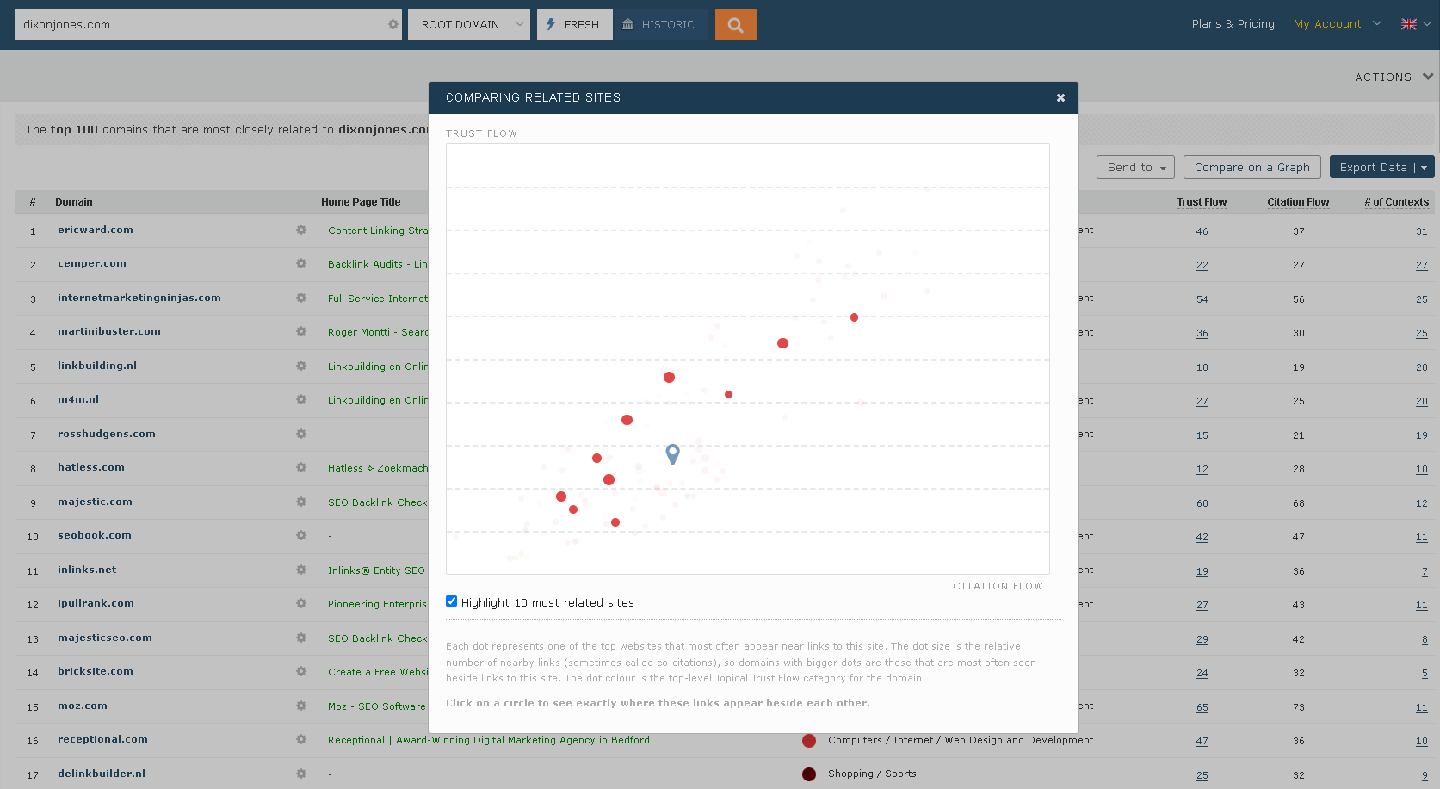
To access this visual graphic representation, create your list of Related Sites and click on the Compare on a Graph button:
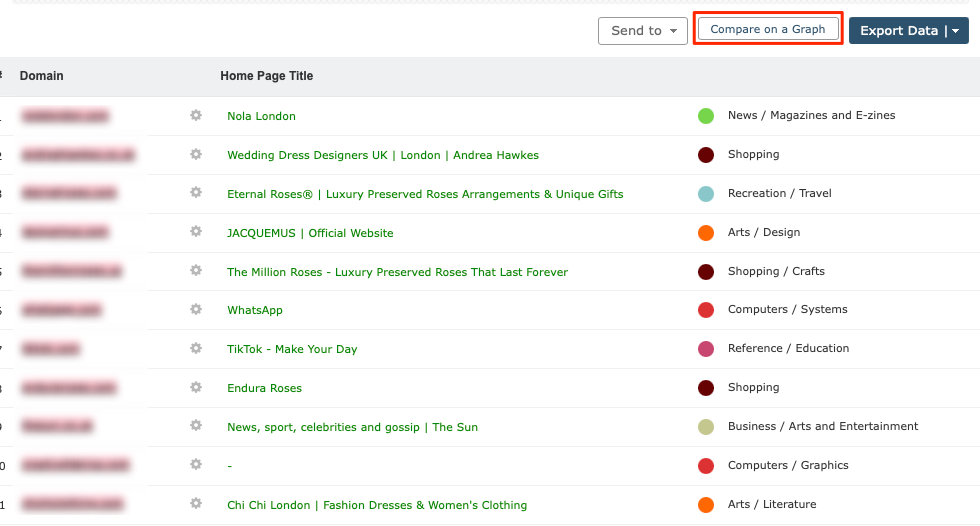
In this example, we can see our website highlighted by the position symbol (blue pin):
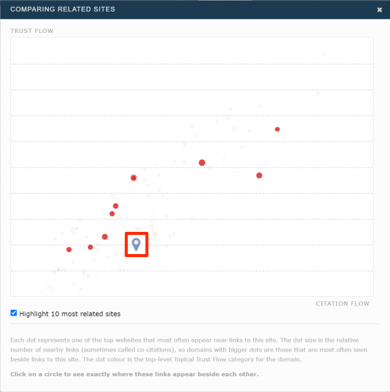
The chart has an immediate visual impact and communicates the URL relative position compared to the other domains. In this example, the Citation Flow value is in line with most sites but could do with a boost in Trust Flow because the score is lower than the other related sites.
These charts also provide an additional, significant insight: websites often linked nearby. Notice the size of the dots in the chart:
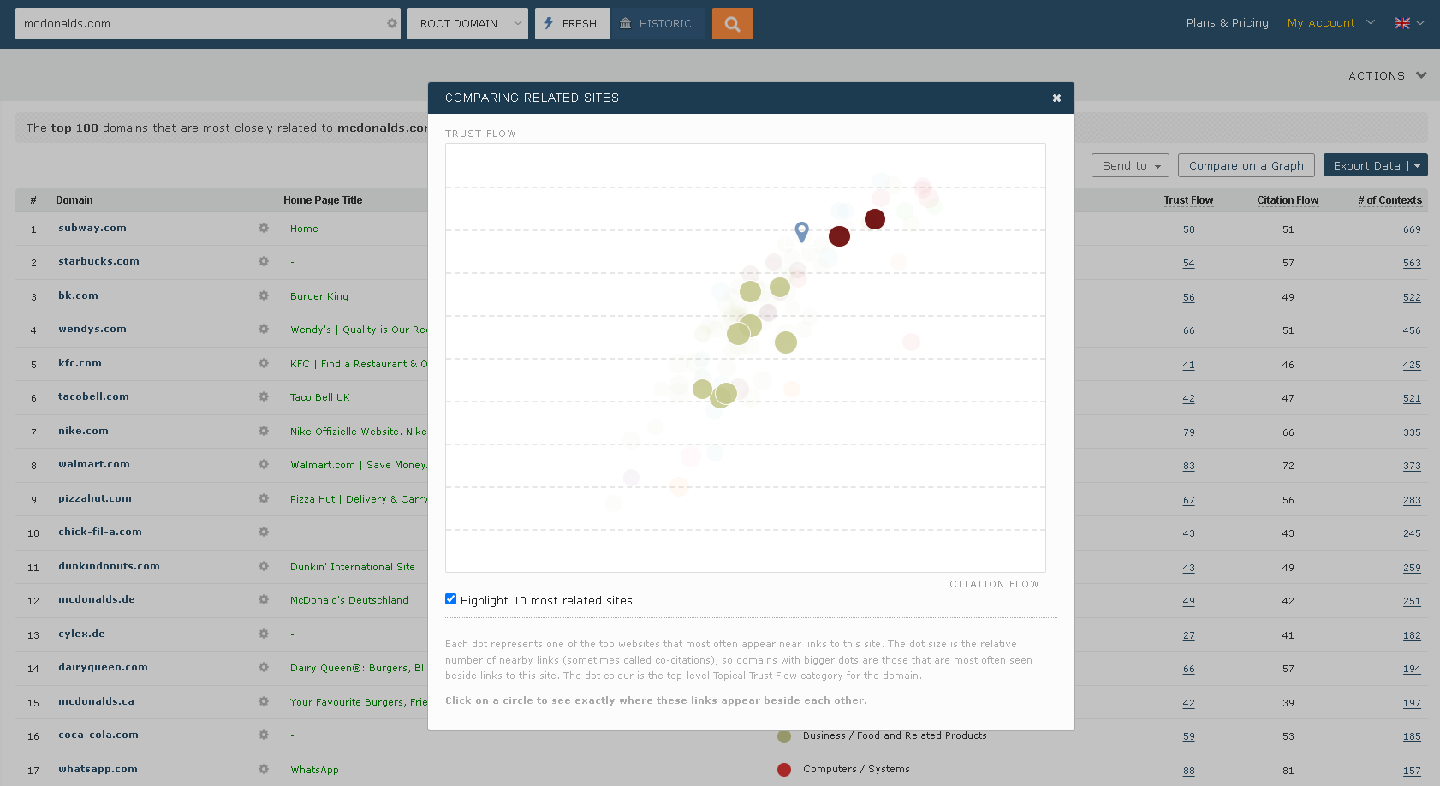
As we see in the previous screenshot, this website is well positioned compared to its peers, with one of the highest Trust Flow Scores. Note the dimensions of the circles and compare them to the ones in the previous example: you'll notice they are larger. Larger dots mean the website has many more co-citations (places where links for different sites are near each other) than the previous example.
Hover over a circle to find out which website it represents.
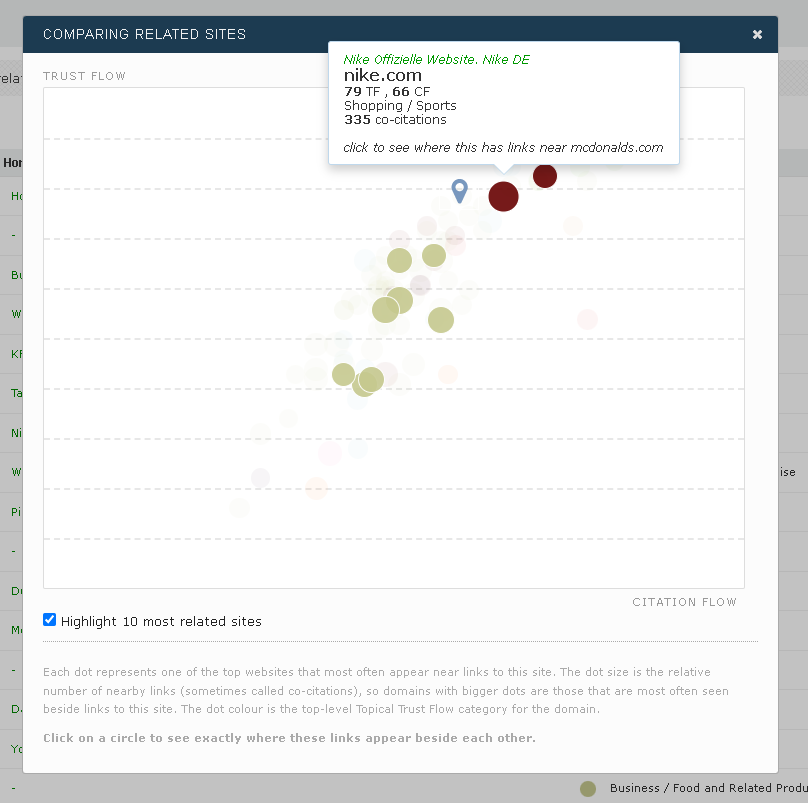
In this example, you'll notice the presence of two dark-red circles - a signal they are related but do not have an affinity. You can create a Link Context filter by clicking on a red circle. The Link Context filter shows exactly where these sites appear:
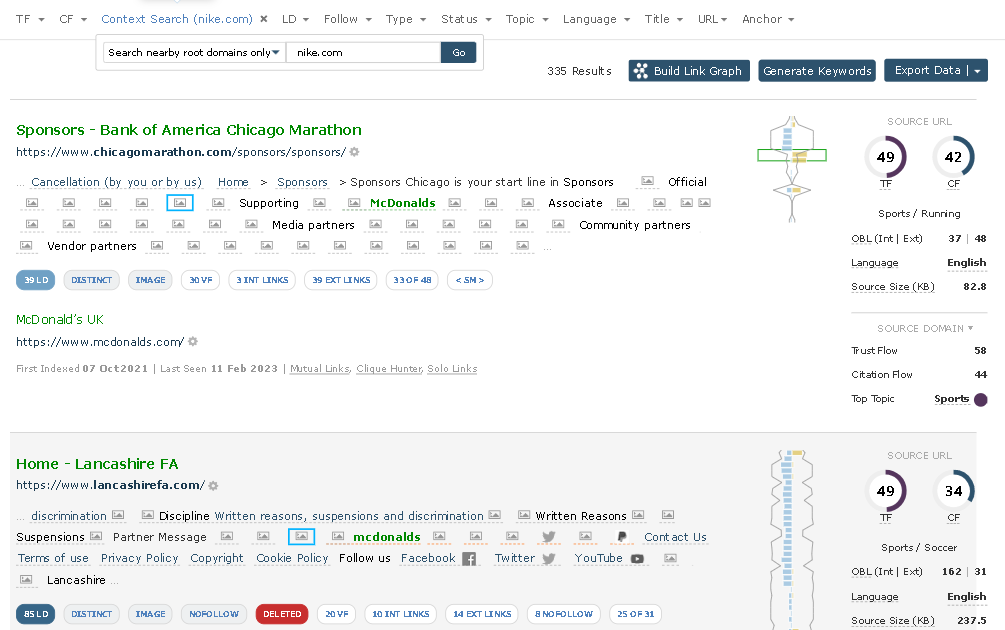
In this example, lists of sponsors on sporting event websites make sure that these companies appear near each other.
Related Sites Report the Top 100 Sites
By default, Related Sites highlights the ten "most related" sites in the chart so far described. In most cases, businesses do not have one hundred competitors. If you need to expand the view and harvest more data for your analyses, you can use the toggle button in the window's bottom-left. The toggle button will expand the graphic to show all 100 related sites. Here is the view of our restaurant once again:
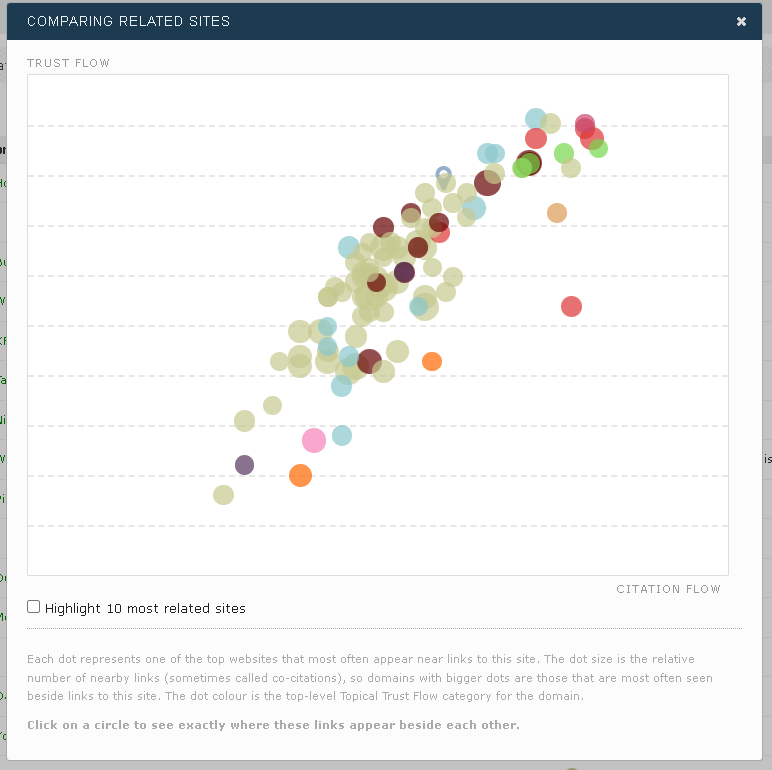
In this view, you can hover over any link to identify it and click to filter the data.
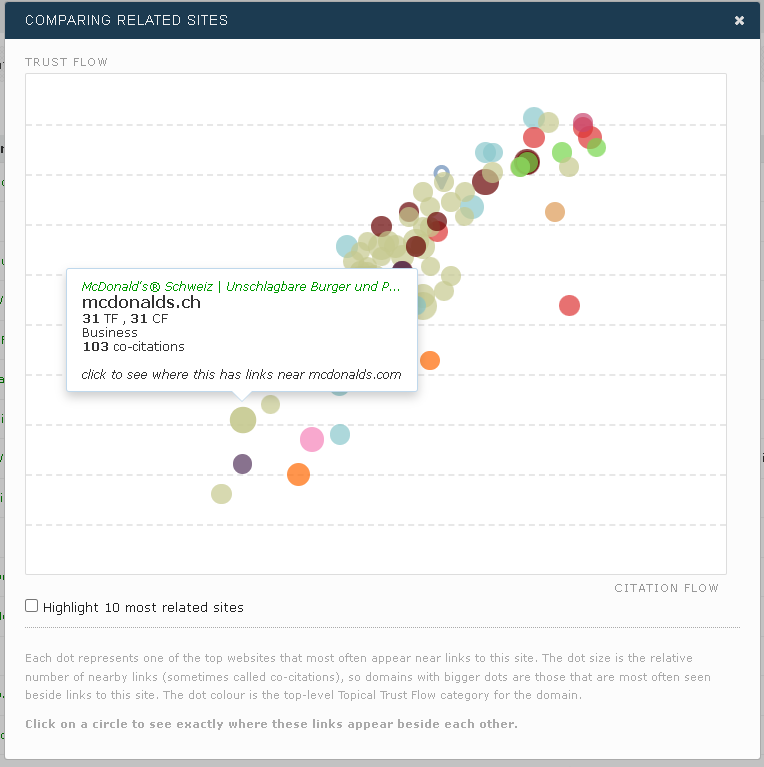
Related Sites is Available to ALL Majestic Subscribers
Related sites is an indispensable tool for SEO professionals and digital marketers to discover and analyse backlinks to websites with an affinity in the online space. By leveraging this data, SEOs can identify competitors or potential partners and build website authority. Related Sites is an essential SEO Tool that will help with:
- Link Building strategy formulation & implementation;
- Backlink Analysis & Research;
- Digital Marketing & Public Relations campaigning;
- Competitor Analyses.
Majestic Related Sites helps position your Brand and contributes towards increasing visibility on search engines within a given niche market.
Try Using Majestic Now
If you would like to take out a Majestic subscription, we strongly believe that our entry-level Lite plan is one of the best value-for-money plans among all the major backlink tools. If you have never used Majestic before, a full 7-day guarantee is available for genuinely new customers on our Lite or Pro plans.
API subscribers have a beta API command to find related sites, making it incredibly easy to get up to 100 similar sites for any URL or domain.
If you have any questions or need assistance, our Customer Service team will be delighted to help.
Free SEO Tools - Site Explorer Backlink Profile Data
Majestic provide free SEO Tools, backlink profile data with Site Explorer. You can access a changing example of free backlink profile data on Site Explorer without signup or validation. We've made this easy to access - just press the orange search icon on the homepage.
The SEO Tools in Site Explorer have a low price of entry, included on the Lite plan at just $49.99 per month. For more details of the subscriptions on offer, please visit our plans and pricing page to view without commitment.
* Access to some SEO tools or resources on Majestic.com are dependent on plan and resources.Could we improve this page for you? Please tell us